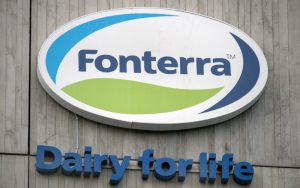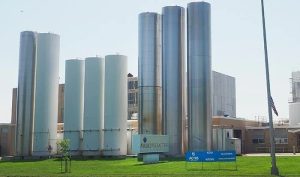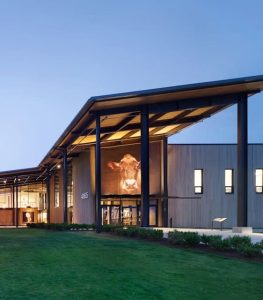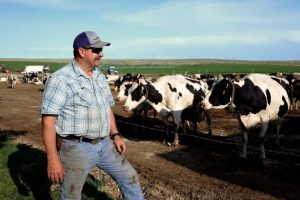
The Emerald Sky Dairy, located in the Town of Emerald, has reached multiple settlements with the state for spills of manure that have contaminated nearby water systems, killed fish and possibly harmed the health of the community’s drinking water. The dairy’s operations have attracted sustained activism from local residents concerned for their health and the cleanliness of their drinking water.
DNR records show the dairy has had seven manure spills since 2016, with two of them resulting in five-figure settlements. The 1,500 cow dairy was required to pay $65,000 as a result of a 2019 spill that caused a major fish kill in a nearby waterway and $80,000 for a 2016 spill that resulted in nearly 300,000 gallons of manure spreading into the nearby wetlands and waterways.
That spill, which was caused by a burst pipe, began in December of 2016, but it wasn’t reported for months. DNR staff only learned of the spill through an anonymous tip and weren’t able to get to the site until March of 2017. There were portions of the facility in which the solid manure was more than three feet deep.
That spring, the cleanup effort began, and tons of solid manure were scraped from two of the wetlands and a nearby stormwater pond on the farm’s property. The water surrounding the farm was severely contaminated. DNR testing found that the stormwater pond had levels of E. coli eight times higher than the level that would force the closure of a public beach. Other contaminants, including phosphorus and ammonia, were elevated as well.
One of the wetlands near the farm, Wetland 1, was also heavily polluted. The level of E. coli in Wetland 1 was 10.5 times higher than the level to close a public beach, but its contamination wasn’t from solid manure. Instead, the DNR found, manure had been dissolved into the water flowing through the wetland.
Dissolved manure ‘not recoverable’
As the dairy worked through the cleanup, Wetland 1 didn’t get the same treatment, a decision that has caused disagreement between the DNR and local activists. And since then, the local water has suffered.
The Town of Emerald Hall is located about a half a mile from the dairy. A public well at the town hall was found to have levels of nitrates — a contaminant often connected to large-scale manure spreading — four times the level considered safe by public health officials. The area’s groundwater is especially vulnerable because of the region’s geology, which is known as Karst geology and contains underground streams, caves and springs.
Residents find the connection hard to miss and have insisted that the failure to do a comprehensive cleanup of Wetland 1 is a major driver of the local groundwater contamination.
“The issue has never gotten resolved. For them to just drop off this whole wetland and not even try to clean it up, I don’t understand the logic behind that,” Kim Dupre, a water quality advocate who used to live near the dairy, told the Wisconsin Examiner in May. “That was never explained.”
DNR staff say the nature of the wetland’s contamination after the spill didn’t allow the type of cleanup other parts of the dairy saw.
“All these documents certainly indicate a discharge of manure and manure-laden water through Wetland 1, that was part of the violations that accumulated the $80,000 forfeiture associated with this event,” Ben Uvaas, the DNR’s CAFO Program Enforcement Coordinator, told the Wisconsin Examiner. “Discharges of pollutants to Wetland 1 in an unlawful manner. So that happened, but that’s different than a cleanup you can recover that material from.”
The manure pollutants in the water, “they’re dissolved by nature, so they’re not going to drop out and you can’t pick them back up in some fashion,” he explained.
The state considers that manure as “just not recoverable material” he continued. “You know, certainly not compared to the other sites or the other parts of the site that remain contaminated.”
Follow-up inspection
This summer, as a result of the continued activism from community members, the DNR conducted an inspection of Wetland 1, looking for evidence of continued manure pollution that neighbors say is there.
In July, Uvaas and agency staff went to the dairy to take soil samples and didn’t find any sign that there was still manure in the area.
“Soils and vegetation appeared normal and unimpacted by throughout. Soil was investigated at five points with a bucket-auger. At each point the soil profile appeared typical for soils mapped in the area,” Uvaas wrote in his report. “The uppermost inches of soil often contained decomposing organic materials typical of a wetland setting. Upon close observation, this material is consistent with predominant vegetation in the area, especially reed canary grass.”
Ultimately, he concluded, “Inspectors did not observe deposited manure solids or other indicators of an un-remediated manure discharge within wetland 1.”
In an email to the Wisconsin Examiner, Uvaas adds that dissolved pollutants eventually get washed downstream and that the agency considers any adverse effects to the local water systems resolved by the settlement agreement and its related fines and cleanup requirements.
“Dissolved pollutants discharged to waterways move downstream over time,” he says. “The phenomenon is often called pollutant fate and transport in related literature. Concerns related to the 2016/2017 spill event were addressed through the civil action, forfeiture, and settlement agreement signed in 2019.”
Residents not satisfied
In a written response to the DNR report, local activists say they feel like their concerns are still waiting to be addressed and that the agency has abandoned their need for clean water.
“WDNR has consistently and repeatedly shown undue deference to this operation since the December 2016 massive manure spill (and even before as evidenced by site inspection findings just prior to the spill) at the cost of the local citizen’s water quality, quality of life, and health/safety,” wrote Steve Oberle, a former Taylor County conservationist who has been working with the local activists and who composed the response.
“Since the massive spill and several others that followed, the fish kill incident, and several WDNR site visits, it has become much clearer to me, to the local folks impacted by [Emerald Sky Dairy], and to many others facing a similar fate around the State just what relative priority and significance WDNR places on water quality (surface water and groundwater) and local citizens’ and community (public) health and safety,” Oberle wrote.
“A fair question – what is the primary role and responsibility of good government (in accord with applicable local ordinances and State statutes) if not to protect public health and safety?” he added.
The dairy’s application to renew its permit to operate as a concentrated animal feeding operation is pending before the DNR. The agency is waiting on the results of a groundwater quality report before moving ahead with the public comment required in any permit renewal.
Oberle concluded his letter to the agency by saying he doesn’t believe the community’s water is safe.
“Unfortunately and regrettably,” he wrote, “I cannot in good conscience tell local citizens that their short- and long-term water quality and health and safety concerns have been fully and completely addressed when thus far WDNR has not produced any water quality (surface water or groundwater) data to support that wetlands, local wells, and streams impacted by multiple spills are in compliance with current surface water quality and groundwater (drinking water) standards.”

























